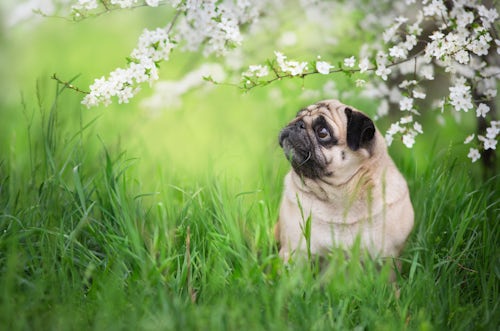As the daffodils bloom and the days lengthen, springtime brings a sense of renewal and vitality. For dog owners in the UK, this season offers a wonderful opportunity to enjoy outdoor adventures with your furry friend. However, along with the joys of spring come challenges and considerations for the health and well-being of your canine companion. From pesky parasites to toxic plants, allergies, exercise routines, and grooming, here are some essential tips for caring for your dog during the Spring season in the UK.

Preventing Parasites
With the warmer temperatures and increased humidity of spring, parasites such as fleas, ticks, and worms become more active. To protect your dog, ensure they are up-to-date on their parasite preventatives prescribed by your veterinarian. Regularly check your dog for ticks after walks in wooded or grassy areas, and consider using tick repellents if necessary. Additionally, keep your dog's environment clean by regularly washing bedding and vacuuming carpets to reduce the risk of flea infestations.

Avoiding Poisonous Plants
Many common springtime plants can be toxic to dogs if ingested. Keep your dog away from plants such as daffodils, tulips, bluebells, and lilies, which can cause symptoms ranging from gastrointestinal upset to more severe reactions. Be vigilant during walks and in your own garden, and familiarize yourself with the plants that pose a threat to your dog's health.
Managing Allergies
Just like humans, dogs can suffer from seasonal allergies triggered by pollen, grasses, and other environmental allergens. If you notice symptoms such as itching, sneezing, or skin irritation, consult your veterinarian for appropriate management options. This may include antihistamines, medicated shampoos, or allergy testing to identify specific triggers.

Exercise Routines
Spring is the perfect time to revitalize your dog's exercise routine and explore the great outdoors together. However, be mindful of the temperature and avoid exercising your dog during the hottest part of the day to prevent overheating. Aim for early morning or evening walks when temperatures are cooler, and always bring water to keep your dog hydrated during outings.
Grooming
Spring brings shedding season for many dog breeds as they lose their winter coats to make way for lighter summer fur. Help manage shedding by regularly brushing your dog to remove loose hair and prevent matting. Pay extra attention to areas such as behind the ears, under the legs, and around the tail where mats are more likely to form. Additionally, consider scheduling a professional grooming appointment to give your dog a fresh start for the season.
Springtime Hazards
Finally, be aware of other potential hazards that can arise during the spring months. This includes puddles of stagnant water, which can harbour bacteria and parasites, as well as seasonal activities such as gardening, which may involve the use of fertilisers, pesticides, and other chemicals that can be harmful to dogs if ingested.
By taking proactive steps to address these springtime challenges, you can ensure that your dog stays happy, healthy, and safe as you both enjoy the beauty and vibrancy of the season. Remember to consult your veterinarian for personalised advice and recommendations tailored to your dog's individual needs. With proper care and attention, you and your canine companion can make the most of springtime adventures in the UK.

.png?ixlib=gatsbyFP&auto=compress%2Cformat&fit=max&w=70&h=70)